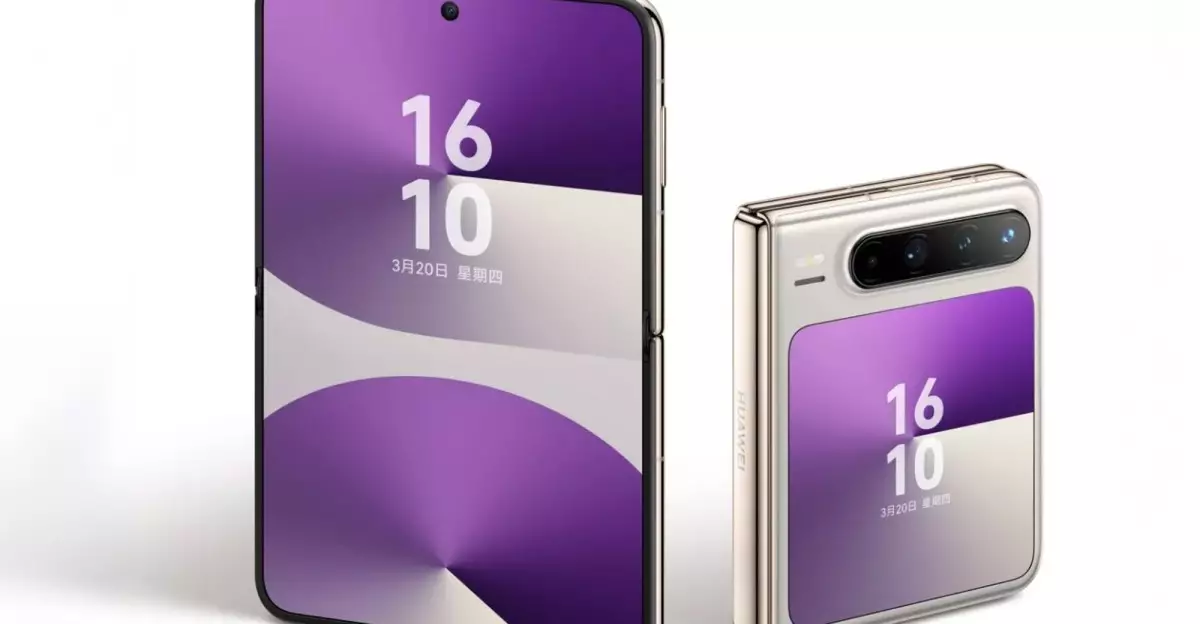Huawei’s newly launched Pura X is an innovative leap into the future of mobile design. Stepping away from the standard vertical flipping mechanisms that have become ubiquitous in flip phones, this device introduces a lateral opening style, creating a form factor that’s reminiscent of small tablets. The sideways flip not only provides a unique feature but enhances usability, offering a more comfortable experience, especially for those who appreciate media consumption on their devices. This design choice marks a key shift in how smartphones are conceptualized, potentially reshaping the direction of mobile technology.
The Pura X is visually striking, boasting a compact body that folds into a palm-sized device. Upon closure, it resembles popular models like the Samsung Galaxy Flip or Motorola Razr, maintaining an elegant and modern aesthetic. The notable difference lies in its hinge design that shifts to the side, revealing a generous 6.3-inch display with a 16:10 aspect ratio—an aspect ratio that favors video playback and multitasking, providing a substantial screen area without the bulk traditionally associated with larger devices.
The Departure from Android
One of the most controversial yet intriguing aspects of the Pura X is its complete departure from the Android operating system. Instead, Huawei has introduced HarmonyOS Next, a brand-new software platform built entirely in-house, thus paving the way for a self-reliant ecosystem. Critics might argue that the lack of Android compatibility poses a significant challenge for users accustomed to the extensive app library available on the Google Play Store. However, Huawei’s bold move could be seen as a strategic maneuver to carve out its niche in a market dominated by established OS providers. By focusing on developing a unique software experience, Huawei aims to cultivate a loyal user base that values innovation over familiarity.
This shift is as much about software as it is about hardware. The Harmony Intelligence AI assistant is bundled with the Pura X and is touted as a significant innovation that could reshape user interaction with mobile devices. Built on Huawei’s proprietary Pangu model and enhanced by DeepSeek technology, Harmony Intelligence promises to streamline tasks, predict user needs, and personalize the overall experience. It’s an ambitious feature that reflects the growing trend towards incorporating AI deeply into our daily technology use, and it is entirely unique to the Pura X.
Industry Perspectives and Market Challenges
The overarching implications of Huawei’s move to introduce the Pura X have not gone unchallenged. Industry stakeholders, including Nvidia’s CEO Jensen Huang, have acknowledged Huawei’s increasing prominence in AI technology, a testament to its relentless pursuit of advancement despite ongoing international restrictions. Huang’s observations highlight how Huawei has managed to weather adversity and emerge as a formidable competitor in the tech landscape.
However, the Pura X’s launch is not without its hurdles. Currently priced at 7,499 yuan (approximately $1,037), it targets a specific segment of consumers willing to invest in leading-edge technology. Initially available only in China, the smartphone’s reach is limited and may hinder its ability to make an international impact. Consumers outside of China may be hesitant to embrace a device that operates in a closed ecosystem devoid of familiar applications. Thus, it remains to be seen how Huawei will navigate these challenges and whether it can attract users who are wary of abandoning mainstream platforms.
Future Implications for Mobile Technology
The Pura X stands at the intersection of a crucial juncture in mobile technology evolution. By embracing a distinctive form factor and foraying into uncharted software territory, Huawei sets a precedent that could inspire competitors to rethink their approaches to smartphone design and functionality. The boldness of this move could invigorate the market, urging other tech giants to pursue greater creativity in their product offerings.
While the immediate focus is on the Pura X, its implications extend beyond a single device. If successful, it could spur a wave of innovation in how we perceive smartphones—not merely as communication tools but as versatile devices capable of adapting to various consumer lifestyles and preferences. The next era of mobile technology hinges upon these daring explorations, with Huawei leading the charge into this adventurous landscape.


Leave a Reply